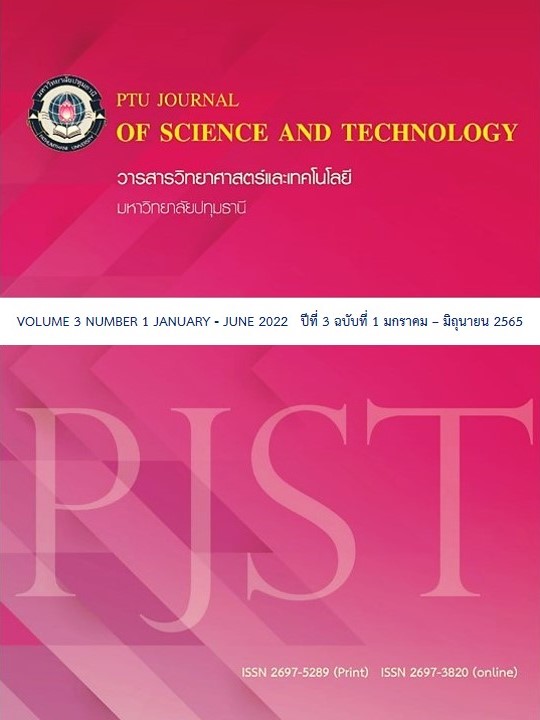ปริมาณน้ำตาลกลูโคสและฟรักโทสในเครื่องดื่มชาและสมุนไพร
Main Article Content
บทคัดย่อ
เครื่องดื่มชาและสมุนไพรบรรขุขวดเป็นที่นิยมดื่มเพื่อความสดชื่นและส่งเสริมสุขภาพ เครื่องดื่มเหล่านี้มักเติมน้ำตาลและน้ำเชื่อมฟรักโทสเพื่อเพิ่มความหวาน ผลวิจัยที่ผ่านมาพบว่าฟรักโทสสามารถเหนี่ยวนำให้เกิดโรคอ้วนและภาวะอ้วนลงพุง ซึ่งสัมพันธ์กับการเกิดโรคเบาหวาน ไขมันพอกตับ ภาวะกรดยูริกสูง และโรคหัวใจและหลอดเลือด งานวิจัยมีวัตถุประสงค์เพื่อศึกษาปริมาณน้ำตาลกลูโคสและฟรักโทสในเครื่องดื่มประเภทชาและสมุนไพรไทยที่จำหน่ายภายใต้เครื่องหมายทางการค้า วิธีการวิจัยทำโดยเลือกตัวอย่างเครื่องดื่มชาและสมุนไพร จำนวน 24 ชนิด ประกอบด้วย เครื่องดื่มประเภทชา ได้แก่ ชาเขียว ชาดำ และชาขาว รวม 15 ชนิดและสมุนไพร ได้แก่ เก๊กฮวย หล่อฮังก๊วย และจับเลี้ยง รวม 9 ชนิด บันทึกข้อมูลโภชนาการ และวิเคราะห์ปริมาณกลูโคสและฟรักโทสด้วยวิธีเอนไซม์เมติก ผลการวิจัยพบว่าค่าเฉลี่ยกลูโคสและฟรักโทสในเครื่องดื่มชา คือ 39.5 ± 23.6 และ 23.7 ± 15.5 มิลลิกรัม/มิลลิลิตร (mean ± SD) ตามลำดับ และค่าเฉลี่ยกลูโคสและฟรักโทสในเครื่องดื่มสมุนไพร คือ 38.5 ± 21.3 และ 24.9 ± 12.4 มิลลิกรัม/มิลลิลิตร (mean ± SD) ตามลำดับ ความเข้มข้นต่ำที่สุดและสูงที่สุดของกลูโคสพบในตัวอย่างเครื่องดื่มชา คือ 7.6 และ 91.6 มิลลิกรัม/มิลลิลิตร ตามลำดับ ในขณะที่กลูโคสต่ำที่สุดและสูงที่สุดในตัวอย่างเครื่องดื่มสมุนไพรคือ 11.6 และ 78.3 มิลลิกรัม/มิลลิลิตร ตามลำดับ ดังนั้น เครื่องดื่มชาและสมุนไพรมีปริมาณกลูโคสและฟรักโทสสูง ซึ่งอาจมีผลต่อสุขภาพเมื่อบริโภคในปริมาณมาก
Article Details

อนุญาตภายใต้เงื่อนไข Creative Commons Attribution-NonCommercial-NoDerivatives 4.0 International License.
ความคิดเห็นและข้อเสนอแนะใดๆ ที่นำเสนอในบทความเป็นของผู้เขียนแต่เพียงผู้เดียว โดยบรรณาธิการ กองบรรณาธิการ และคณะกรรมการวารสารวิทยาศาสตร์และเทคโนโลยี มหาวิทยาลัยปทุมธานี ไม่ได้มีส่วนเกี่ยวข้องแต่อย่างใด มหาวิทยาลัย บรรณาธิการ และกองบรรณาธิการจะไม่รับผิดชอบต่อข้อผิดพลาดหรือผลที่เกิดจากการใช้ข้อมูลที่ปรากฏในวารสารฉบับนี้
เอกสารอ้างอิง
ประไพศรี ศิริจักรวาล. (2549). นํ้าตาล ทำไมต้อง 6 ช้อนชา. สำนัก โภชนาการ กรมอนามัย กระทรวง สาธารณสุข เอกสาร เผยแพร่เครือข่าย “เด็กไทยไม่กินหวาน” สืบค้นวันที่ 24 กรกฎาคม 2555 เข้าถึงได้จาก http://nutrition.anamai. moph.go.th/temp/main/view.php?group=3&id=71
Memon, M. Q., & Kumar, A. (2013). The fructose mystery: how bad or good is it?. Pakistan journal of pharmaceutical sciences, 26(6), 1241–1245.
Poswal, F. S., Russell, G., Mackonochie, M., MacLennan, E., Adukwu, E. C., & Rolfe, V. (2019). Herbal Teas and their Health Benefits: A Scoping Review. Plant foods for human nutrition (Dordrecht, Netherlands), 74(3), 266–276. https://doi.org/10.1007/s11130-019-00750-w
Rizkalla S. W. (2010). Health implications of fructose consumption: A review of recent data. Nutrition & metabolism, 7, 82. https://doi.org/10.1186/1743-7075-7-82
Segal, M. S., Gollub, E., & Johnson, R. J. (2007). Is the fructose index more relevant with regards to cardiovascular disease than the glycemic index?. European journal of nutrition, 46(7), 406–417. https://doi.org/10.1007/s00394-007-0680-9
Sun, S. Z., Anderson, G. H., Flickinger, B. D., Williamson-Hughes, P. S., & Empie, M. W. (2011). Fructose and non-fructose sugar intakes in the US population and their associations with indicators of metabolic syndrome. Food and chemical toxicology: an international journal published for the British Industrial Biological Research Association, 49(11), 2875–2882. https://doi.org/10.1016/j.fct.2011.07.068
Ventura, E. E., Davis, J. N., & Goran, M. I. (2011). Sugar content of popular sweetened beverages based on objective laboratory analysis: focus on fructose content. Obesity (Silver Spring, Md.), 19(4), 868–874. https://doi.org/10.1038/oby.2010.255
White J. S. (2008). Straight talk about high-fructose corn syrup: what it is and what it ain't. The American journal of clinical nutrition, 88(6), 1716S–1721S. https://doi.org/10.3945/ajcn.2008.25825B
Zhao, C. N., Tang, G. Y., Cao, S. Y., Xu, X. Y., Gan, R. Y., Liu, Q., Mao, Q. Q., Shang, A., & Li, H. B. (2019). Phenolic Profiles and Antioxidant Activities of 30 Tea Infusions from Green, Black, Oolong, White, Yellow and Dark Teas. Antioxidants (Basel, Switzerland), 8(7), 215. https://doi.org/10.3390/antiox8070215


